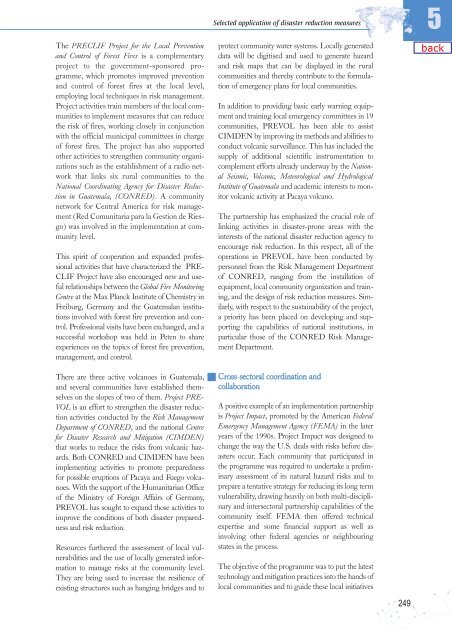Living with Risk. A global review of disaster reduction initiatives
Living with Risk. A global review of disaster reduction initiatives
Living with Risk. A global review of disaster reduction initiatives
You also want an ePaper? Increase the reach of your titles
YUMPU automatically turns print PDFs into web optimized ePapers that Google loves.
The PRECLIF Project for the Local Prevention<br />
and Control <strong>of</strong> Forest Fires is a complementary<br />
project to the government-sponsored programme,<br />
which promotes improved prevention<br />
and control <strong>of</strong> forest fires at the local level,<br />
employing local techniques in risk management.<br />
Project activities train members <strong>of</strong> the local communities<br />
to implement measures that can reduce<br />
the risk <strong>of</strong> fires, working closely in conjunction<br />
<strong>with</strong> the <strong>of</strong>ficial municipal committees in charge<br />
<strong>of</strong> forest fires. The project has also supported<br />
other activities to strengthen community organizations<br />
such as the establishment <strong>of</strong> a radio network<br />
that links six rural communities to the<br />
National Coordinating Agency for Disaster Reduction<br />
in Guatemala, (CONRED). A community<br />
network for Central America for risk management<br />
(Red Comunitaria para la Gestion de Riesgo)<br />
was involved in the implementation at community<br />
level.<br />
This spirit <strong>of</strong> cooperation and expanded pr<strong>of</strong>essional<br />
activities that have characterized the PRE-<br />
CLIF Project have also encouraged new and useful<br />
relationships between the Global Fire Monitoring<br />
Centre at the Max Planck Institute <strong>of</strong> Chemistry in<br />
Freiburg, Germany and the Guatemalan institutions<br />
involved <strong>with</strong> forest fire prevention and control.<br />
Pr<strong>of</strong>essional visits have been exchanged, and a<br />
successful workshop was held in Peten to share<br />
experiences on the topics <strong>of</strong> forest fire prevention,<br />
management, and control.<br />
Selected application <strong>of</strong> <strong>disaster</strong> <strong>reduction</strong> measures<br />
protect community water systems. Locally generated<br />
data will be digitised and used to generate hazard<br />
and risk maps that can be displayed in the rural<br />
communities and thereby contribute to the formulation<br />
<strong>of</strong> emergency plans for local communities.<br />
In addition to providing basic early warning equipment<br />
and training local emergency committees in 19<br />
communities, PREVOL has been able to assist<br />
CIMDEN by improving its methods and abilities to<br />
conduct volcanic surveillance. This has included the<br />
supply <strong>of</strong> additional scientific instrumentation to<br />
complement efforts already underway by the National<br />
Seismic, Volcanic, Meteorological and Hydrological<br />
Institute <strong>of</strong> Guatemala and academic interests to monitor<br />
volcanic activity at Pacaya volcano.<br />
The partnership has emphasized the crucial role <strong>of</strong><br />
linking activities in <strong>disaster</strong>-prone areas <strong>with</strong> the<br />
interests <strong>of</strong> the national <strong>disaster</strong> <strong>reduction</strong> agency to<br />
encourage risk <strong>reduction</strong>. In this respect, all <strong>of</strong> the<br />
operations in PREVOL have been conducted by<br />
personnel from the <strong>Risk</strong> Management Department<br />
<strong>of</strong> CONRED, ranging from the installation <strong>of</strong><br />
equipment, local community organization and training,<br />
and the design <strong>of</strong> risk <strong>reduction</strong> measures. Similarly,<br />
<strong>with</strong> respect to the sustainability <strong>of</strong> the project,<br />
a priority has been placed on developing and supporting<br />
the capabilities <strong>of</strong> national institutions, in<br />
particular those <strong>of</strong> the CONRED <strong>Risk</strong> Management<br />
Department.<br />
5<br />
There are three active volcanoes in Guatemala,<br />
and several communities have established themselves<br />
on the slopes <strong>of</strong> two <strong>of</strong> them. Project PRE-<br />
VOL is an effort to strengthen the <strong>disaster</strong> <strong>reduction</strong><br />
activities conducted by the <strong>Risk</strong> Management<br />
Department <strong>of</strong> CONRED, and the national Centre<br />
for Disaster Research and Mitigation (CIMDEN)<br />
that works to reduce the risks from volcanic hazards.<br />
Both CONRED and CIMDEN have been<br />
implementing activities to promote preparedness<br />
for possible eruptions <strong>of</strong> Pacaya and Fuego volcanoes.<br />
With the support <strong>of</strong> the Humanitarian Office<br />
<strong>of</strong> the Ministry <strong>of</strong> Foreign Affairs <strong>of</strong> Germany,<br />
PREVOL has sought to expand those activities to<br />
improve the conditions <strong>of</strong> both <strong>disaster</strong> preparedness<br />
and risk <strong>reduction</strong>.<br />
Resources furthered the assessment <strong>of</strong> local vulnerabilities<br />
and the use <strong>of</strong> locally generated information<br />
to manage risks at the community level.<br />
They are being used to increase the resilience <strong>of</strong><br />
existing structures such as hanging bridges and to<br />
Cross-sectoral coordination and<br />
collaboration<br />
A positive example <strong>of</strong> an implementation partnership<br />
is Project Impact, promoted by the American Federal<br />
Emergency Management Agency (FEMA) in the later<br />
years <strong>of</strong> the 1990s. Project Impact was designed to<br />
change the way the U.S. deals <strong>with</strong> risks before <strong>disaster</strong>s<br />
occur. Each community that participated in<br />
the programme was required to undertake a preliminary<br />
assessment <strong>of</strong> its natural hazard risks and to<br />
prepare a tentative strategy for reducing its long term<br />
vulnerability, drawing heavily on both multi-disciplinary<br />
and intersectoral partnership capabilities <strong>of</strong> the<br />
community itself. FEMA then <strong>of</strong>fered technical<br />
expertise and some financial support as well as<br />
involving other federal agencies or neighbouring<br />
states in the process.<br />
The objective <strong>of</strong> the programme was to put the latest<br />
technology and mitigation practices into the hands <strong>of</strong><br />
local communities and to guide these local <strong>initiatives</strong><br />
249

















